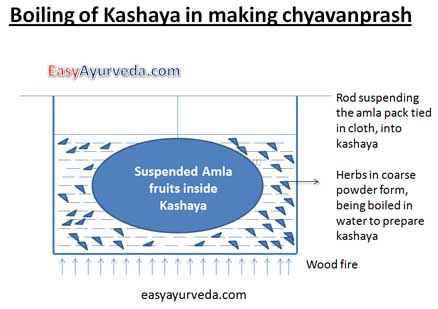How To Make Chyavanprash? 5 Hidden Pharma Principles
Table of Contents
Introduction
Chyavanprash is a paste or herbal jam preparation. This dosage form is called Avaleha, lehyam or leha in Ayurveda. It is grouped as one of the prime among the rejuvenating and anti ageing medicines (Rasayana).
Chyavanprash is made of sugar candy or sugar base. It has Amla – Indian gooseberry as the main ingredient.
There are many references to Chyawanprash.
Among them, two are considered as main, in pharma Industry.
- Charaka Samhita Chikitsa Sthana 1.1/62-74
- Sharangdhara Samhita Madhyama Khanda Avaleha chapter
- Read related: Chyawanprash Uses, Dose, How To Take, Ingredients, Side Effects
Principles in manufacturing
How to make Chyavanprash? Principles involved in manufacturing
- Kashaya preparation (herbs coarse powder – boiling in water)
- Tie 500 Amla fruits in a cloth. Make it to suspend in the above kashaya while it is boiling.
- After kashaya is made, filter it and keep it ready.
- Take out these amla fruits out of the cloth pack, remove seeds, fry in ghee for 5 – 10 minutes till the whole mass becomes homogenous mix.
- Take the kashaya – add sugar, add ghee fried amla pulp start heating.
- Wait till the total mass becomes sticky, semi-solid.
- Stop heating.
- Allow it cool down
- Add Spices (also called Prakshepa)
- Allow it to cool down further
- Add honey, mix and store.

Kashaya preparation
Part 1 – Boiling of Kashaya –
A set of herbs – 48 grams is taken and boiled in 12.288 liters of water, boiled and reduced to 3.072 liters. Filtered.
While boiling it, 500 amla fruits are taken and tied as a pack and suspended in this boiling kashaya.
Rules for preparing Kashaya
- Do not close the lid on the vessel.
- Stir continuously or else the herbs may settle at the bottom of the vessel. It may lead to charring.
- Basic proportion of herbs + water is 1:16
- It is boiled till only 4 parts remains.
- Coarse powder of raw materials make it easier to filter. Fine powder makes it difficult to filter.
- Maintain low flame especially after the kashaya starts boiling.
- Read related: Kashayam preparation – Easy Rules To Follow
Herbs for kashaya
Kashaya herbs – as per Charaka –
Bilva – Aegle marmelos
Agnimantha – Premna mucronata
Shyonaka – Oroxylum indicum
Kashmarya – Gmelina arborea
Patali – Stereospermum suaveolens
Bala – Country mallow – Sida cordifolia
Shalaparni – Desmodium gangeticum
Prishniparni – Uraria picta
Mashaparni – Teramnus labialis
Mudgaparni – Phaseolus trilobus
Pippali – Long pepper
Shvadamstra – Tribulus terrestris
Brihati – Solanum indicum
Kantakari – Solanum surattense
Shringi – Pistacia chinensis
Tamalaki – Phyllanthus niruri
Draksha – Grapes
Jivanti – Leptadenia reticulata
Pushkara – Inula racemosa
Aguru – Aquilaria agallocha
Abhaya – Harad – Terminalia chebula
Riddhi – Habenaria intermedia
Jivaka – Malaxis acuminata
Rishabhaka – Manilkara hexandra
Shati – Zadoary (root) – Hedychium spicatum / Curcuma zeodaria
Musta – Cyperus rotundus
Punarnava – Boerhavia diffusa
Meda – Polygonatum cirrhifolium
Ela – Cardamom
Chandana – Sandalwood
Utpala – Water Lily
Vidari – Pureria tuberosa
Vrusha – Adhatoda vasica
Kakoli – Fritillaria roylei
Kakanasika – Martynia annua
Filtering the kashaya
Part 2 – Filter the kashaya, add sugar and filter again.
After 12.288 liters of water in kashaya is boiled and reduced to 3.072 liters, the amla pack is taken out. The kashaya is filtered.
2.4 kg of Sugar is added when the Kashaya is still hot.
If it is hot, then it makes the sugar mixing very easy.
Dissolved.
This is again filtered to get rid of remaining waste particles of sugar from the Kashaya.
Amla frying in ghee
Part 3- de-seed amlas, fry the amla pulp in ghee.
After taking out amla fruits from the cloth packs, it is mashed and seeds are removed. To this, 567 grams of ghee is added and fried. (Master Charaka mentions to add equal amount of sesame oil to it).
After removing the seeds, some people remove the fibre part of the amla fruits by filtering through a cloth.
Take care not to fry amla in ghee for very long time. It may burn the paste
Boiling of kashaya
Part 4 – Fried amla+kashaya + sugar -> boil
Ghee fried amla is added to the kashaya+sugar solution. It is boiled.
Boiling is continued till leha siddha lakshana (signs of completion of jams) is seen.
Avaleha Siddha Lakshana
Tantumatva – thread consistency
If you take a small piece of the mix between your thumb and index finger, you can make 1-2 threads
Peedite Mudra – a part of the mix is allowed to cool down. After that, it is pressed with finger. The finger prints become visible on the semi solid mix.
This sign is more appreciable after completion of chyawanprash making.
Signs to observe while boiling the sugar + kashaya + amla pulp mix
- The solution starts thickening.
- Gandha Varna Rasodhbhava – The good aroma of amla and ghee becomes more and more appreciable.
- Apsu Majjati – If you drop the mix into water, it settles down at the bottom, without spreading much.
Prakshepa Dravyas
Part 5: Semisolid mass -> stop heating add spices (prakshepa) -> add honey
Once the Kashaya turns semisolid and all the leha completion signs are found, it is taken out of fire. Allowed to cool down.
It is added with
6 Pala – 288 g of honey;
4 Pala – 192 g of Tugaksiri;
2 Pala – 96 g of Pippali – Long pepper
1 pala – 48 g of each of –
Twak – Cinnamon
Ela – Cardamom
Patra – Cinnamon leaves
Keshara – Nagakeshar – Mesua ferrea
All the above are added when the semisolid mass is still lukewarm. It is stirred continuously to obtain a blackish-brown.
And THAT is how, my friend, your Chyawanprash is made.
Watch the video below









